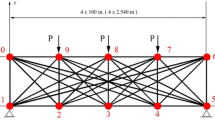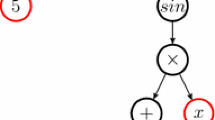Abstract
The optimal truss design using problem-oriented evolutionary algorithm is presented in the paper. The minimum weight structures subjected to stress and displacement constraints are searched. The discrete design variables are areas of members, selected from catalogues of available sections. The integration of the problem specific knowledge into the optimization procedure is proposed. The heuristic rules based on the concept of fully stressed design are introduced through special genetic operators, which use the information concerning the stress distribution of structural members. Moreover, approximated solutions obtained by deterministic, sequential discrete optimization methods are inserted into the initial population. The obtained hybrid evolutionary algorithm is specialized for truss design. Benchmark problems are calculated in numerical examples. The knowledge about the problem integrated into the evolutionary algorithm can enhance considerably the effectiveness of the approach and improve significantly the convergence rate and the quality of the results. The advantages and drawbacks of the proposed method are discussed.
Similar content being viewed by others

References
J. S. Arora, M. W. Huang, and C. C. Hsieh, “Methods for optimization of nonlinear problems with discrete variables: A review,” Structural Optimization vol. 8, pp. 69–85, 1994.
J. Bauer, “A survey of methods for discrete optimum structural design,” Computer Assisted Mechanics & Engineering Sciences vol. 1,nos. 1/2, pp. 27–38, 1994.
S. Botello, J. L. Marroquin, E. Onate, and J. Van Horebeek, “Solving structural optimization problems with genetic algorithms and simulated annealing,” International Journal for Numerical Methods in Engineering vol. 45, pp. 1069–1084, 1999.
C. Camp, S. Pezeshk, and G. Cao, “Optimized design of two-dimensional structures using a genetic algorithm,” Journal of Structural Engineering, 124 vol. 5, pp. 551–559, 1998.
L. Davis, Handbook of Genetic Algorithms, Van Nostrand Reinhold: New York, 1991.
D. E. Goldberg, Genetic Algorithms in Search, Optimization and Machine Learning, Addison Wesley: Reading, 1989.
D. E. Goldberg and M. P. Samatini, “Engineering optimization via genetic algorithms,” in Proceedings of the Ninth Conference on Electronic Computation, 1986, pp. 471–482.
D. Greiner, G. Winter, and J. M. Emperador, “Optimising frame structures by different strategies of genetic algorithms,” Finite Elements in Analysis and Design vol. 37, pp. 381–402, 2001
A. A. Groenwold, N. Stander, and J. A. Snyman, “A regional genetic algorithm for the discrete design of truss structures,” International Journal for Numerical Methods in Engineering vol. 44, pp. 749–766, 1999.
W. Gutkowski, J. Bauer, and J. Zawidzka, “An effective method for discrete structural optimization,” Engineering Computations vol. 17,no. 4, pp. 417–426, 2000.
W. Gutkowski and J. Zawidzka, “Sequential algorithm for discrete minimum weight design of structures,” in Structural and Multidisciplinary Optimization WCSMO-2, W. Gutkowski and Z. Mroz (Eds.), Wydawnictwo Ekoinzynieria, Zakopane, Poland, 1997, pp. 313–318.
P. Hajela, “Genetic search—An approach to the nonconvex optimization problem,” AIAA Journal vol. 26,no. 7, pp. 1205–1210, 1990.
O. Hasancebi and F. Erbatur, “Evaluation of crossover techniques in genetic algorithm based optimum structural design,” Computers and Structures, vol. 78, pp. 435–448, 2000.
E. J. Haug and J. S. Arora, Mechanical and Structural Systems, J. Wiley: New York, 1979.
M.W. Huang and J. S. Arora, “Optimal design of steel structures using standard sections,” Structural Optimization, vol. 14, pp. 24–35, 1997.
W. M. Jenkins, “Towards structural optimization via genetic algorithm,” Computers and Structures vol. 40,no. 5, pp. 1321–1327, 1991.
Z. Michalewicz, Genetic Algorithms + Data Structures = Evolution Programs, Springer Verlag: Berlin, Heidelberg, New York, 1992.
P. Moscato, “On evolution, search, optimization, genetic algorithms and martial arts:Towards memetic algorithms,” Caltech Concurrent Computation Program Report, 826, California Institute of Technology, Pasadena, CA, 1989.
P. Moscato, “Memetic algorithms using guided local search: A case study,” in New Ideas in Optimization, D. Corne, M. Dorgio, and F. Glover (Eds.), McGraw-Hill: London, 1999.
A. Osyczka, Evolutionary Algorithms for Single and Multicriteria Design Optimization, Springer Physica-Verlag: Heidelberg, New-York, 2002.
S. N. Patnaik and D. A. Hopkins, “Optimality of a fully stressed design,” Computer Methods in Applied Mechanics and Engineering vol. 165, pp. 215–221, 1998.
M. Pyrz and J. Zawidzka, “Optimal discrete truss design using improved sequential and genetic algorithm,” Engineering Computations vol. 18,no. 8, pp. 1078–1090, 2001.
P. B. Thanedar and G. N. Vanderplaats, “Survey of discrete variable optimization for structural design,” Journal of Structural Engineering vol. 121,no. 2, pp. 301–306, 1995.
Author information
Authors and Affiliations
Rights and permissions
About this article
Cite this article
Pyrz, M. Evolutionary Algorithm Integrating Stress Heuristics for Truss Optimization. Optimization and Engineering 5, 45–57 (2004). https://doi.org/10.1023/B:OPTE.0000013634.36489.32
Issue Date:
DOI: https://doi.org/10.1023/B:OPTE.0000013634.36489.32



